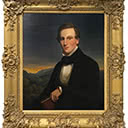Portrait of John Logan Campbell (1817-1912), the Father of Auckland, New Zealand
77 x 64 cm
est. $20,000 - 30,000
Presented in period gilt frame; verso with framer's label of Doig, Wilson & Wheatley, 90 George Street, Edinburgh (the firm was established in 1840 but traded under this name 1895-1957), together with manuscript labels with title and date
A rare portrait painting, by John Watson Gordon, a significant Scottish artist, of John Logan Campbell (1817-1912), painted shortly before his departure for Australia and New Zealand. Campbell arrived at Auckland in April, 1840, and is often referred to as the Father of Auckland. As a businessman, politician and philanthropist, his contribution to the development of the city was unequalled by any of Auckland's other prominent citizens during the 19th century. This portrait captures the integrity, astuteness and vision of the handsome and capable young Scotsman in the prime of youth. The identity of the sitter is corroborated by another portrait of Campbell painted in the following year by Mungo Burton (1799-1882), held in the Yale Center for British Art, Paul Mellon Collection, titled John Logan Campbell in the club dress of the Edinburgh Alleion Archers (1838). The only other known painted portraits of Campbell were done very late in his life: by Mabel Hill in 1901 (National Library of New Zealand), and by Louis John Steele, first in 1903 sold by International Art Centre in August 2017 and realising $425,000, a record for the artist), and then again in 1910 held in the collection of Auckland Art Gallery.
The artist of the present work, John Watson Gordon (Scottish, 1788-1864), 'was training to become an army engineer when, encouraged by his uncle, the painter, George Watson, and Raeburn, who was a family friend, he decided to become an artist. His first works were subject pictures but, after Raeburn's death in 1823, he established himself as the leading portrait painter in Scotland. His style was at first closely based on Raeburn but was later more influenced by his admiration for Velázquez. In 1850 he was elected President of the Royal Scottish Academy, appointed Queen's Limner for Scotland and knighted.' (National Galleries of Scotland).
John Logan Campbell was born at Edinburgh on 3 November 1817. His father was Dr John Campbell (1784-1867), son of Sir James Campbell, of Aberu- chill and Kilbryde, and his mother was Catherine née Logan (1788-1865). It seems that it was because of parental pressure rather than of a love for medicine that John Logan went to Edinburgh University, where he graduated M.D. and F.R.C.S. Determined to see something of the world, he sought a commission as medical officer in the East India Company; but as opportunities for settlement were offering in Australia, he decided to emigrate there, and sailed in the Palmyra as ship's doctor on 3 July 1839, arriving in Australia later that year.
His gifts to Auckland city are too numerous to list, but he gave generously to such institutions as children's homes and St. John Ambulance - in fact, any organisation which was of benefit to the citizens of Auckland had his practical sympathy. His greatest gift, however, was that of the magnificent Cornwall Park.
Originally purchased in 1845 by Thomas Henry, it was bought by Brown and Campbell in 1853. In 1901, when the Duke and Duchess of Cornwall and York visited New Zealand, Campbell was made Mayor to receive them and to present the citizens' address of welcome. He had intended to bequeath the park to the city, but it seemed to him a fitting opportunity to present it to "the people of New Zealand" through the hands of their Royal Highnesses. Campbell's own name for it had been Corinth Park, but in honour of the royal visitors, he changed it to Cornwall Park. Campbell was knighted in 1902 and died at Parnell's Kilbryde, June 1912 in his ninety-fifth year.
John Logan Campbell became one of Auckland's best known and respected citizens. Although always known as 'Dr Campbell', he concerned himself little with medicine, a profession which held no attractions for him and which, as a calling, he considered much inferior to business.
Reference: Father of Auckland - An Encyclopedia of New Zealand, Enid Annie Evans





